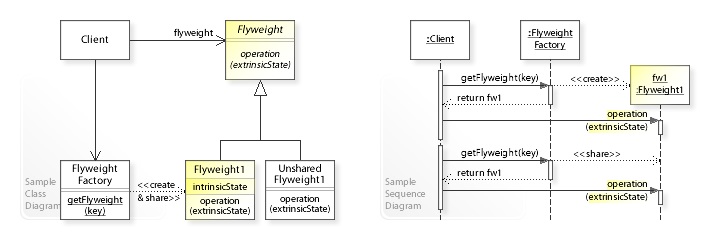Flyweight
The Flyweight pattern is a structural design pattern used primarily to reduce the number of objects created, to decrease memory footprint and increase performance. This pattern is particularly useful when a program requires a large number of similar objects with few states that can be shared.
Concept

Flyweight pattern in the Wikipedia
- Intrinsic State: This is the state that is shared across many objects. It's stored in the flyweight object. This state is not unique to each object and is often immutable.
- Extrinsic State: This is the state that varies between objects and is not shared. Clients store this state and pass it to the flyweight when its behavior is invoked.
- Flyweight Factory: This is responsible for creating and managing flyweight objects. It ensures that flyweights are shared correctly. When the client requests a flyweight, the factory either returns an existing instance or creates a new one if it doesn't exist.
Use Cases
The Flyweight pattern is particularly useful in scenarios where you're dealing with large numbers of objects that have some shared state. Examples include:
- Character objects in a word processor (where each character might have a font and size - the intrinsic state, but position and color - the extrinsic state).
- Trees in a forest simulation (where each tree might share species, texture, and color but have different positions and sizes).
Implementation in TypeScript
class Flyweight {
private intrinsicState: any;
constructor(intrinsicState: any) {
this.intrinsicState = intrinsicState;
}
public operation(extrinsicState: any): void {
// Implementation of some action with intrinsic and extrinsic state
}
}
class FlyweightFactory {
private flyweights: {[key: string]: Flyweight} = {};
public getFlyweight(key: string): Flyweight {
if (!(key in this.flyweights)) {
this.flyweights[key] = new Flyweight(key);
}
return this.flyweights[key];
}
}
// Usage
const factory = new FlyweightFactory();
const flyweight1 = factory.getFlyweight("sharedState1");
const flyweight2 = factory.getFlyweight("sharedState1");
// Both flyweight1 and flyweight2 share the same intrinsic state
Common usage scenarios
The Flyweight pattern is particularly useful in scenarios where a program must handle a large number of objects with many shared properties, allowing for efficient use of memory. Here are some common use scenarios:
-
Graphical Applications: In graphics software or games, where numerous objects are rendered, the Flyweight pattern can be used to reduce the memory footprint. For example, in a game, trees, bullets, or characters might share common properties like textures or models.
-
Text Formatting: Word processors or text editing software often use the Flyweight pattern. Characters in a document can share the font style, size, and color, which are intrinsic states, while the position of each character on a page is an extrinsic state.
-
User Interface Elements: In UI frameworks, the Flyweight pattern can be used to manage state and behavior of UI components that are repetitive but share common properties, such as buttons, icons, or text fields.
-
Database-Driven Applications: When dealing with large datasets, such as in database systems, flyweights can be used to represent shared data in a memory-efficient manner, reducing the load on the database.
-
Networking: In networked applications, such as web servers, the Flyweight pattern can be used to handle a large number of lightweight client sessions with shared settings or configurations.
-
Object Pooling: The Flyweight pattern is often used in conjunction with object pools, which manage the instantiation and lifecycle of a large number of objects of the same class.
Tips for Fullstack Developers
- In a fullstack environment, consider using the Flyweight pattern to optimize memory usage on both the client and server sides.
- In a React application, you might apply this pattern for components that are reused frequently with similar properties, reducing the overall number of component instances.
- Be cautious about overusing this pattern, especially in scenarios where object uniqueness is more important than memory savings. The added complexity might not always justify the performance gains.
- When working with state management in frontend frameworks, the Flyweight pattern can help in efficiently managing shared state across multiple components.
- When implementing the Flyweight pattern in a web application, consider how you might use it to optimize performance, especially in the front-end (like React) where rendering large numbers of components can be expensive.
- In React, for instance, you might use this pattern to reuse component instances or share common data across components efficiently.
- Remember that while this pattern can improve performance by reducing memory usage, it can also add complexity. Use it only when the performance benefit is significant.